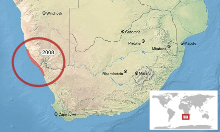Desert rain frog
| Breviceps macrops | |
|---|---|
| Scientific classification | |
| Kingdom: | Animalia |
| Phylum: | Chordata |
| Class: | Amphibia |
| Order: | Anura |
| Family: | Brevicipitidae |
| Genus: | Breviceps |
| Species: | B. macrops |
| Binomial name | |
| Breviceps macrops Boulenger, 1907 | |
 | |
The desert rain frog, Breviceps macrops, is a species of frog in the family Brevicipitidae.[2] It is found in Namibia and South Africa. Its natural habitat is the narrow strip of sandy shores between the sea and the sand dunes. It is threatened by habitat loss.[1]
Description
The desert rain frog is a small, plump species with bulging eyes, a short snout, short limbs, spade-like feet and webbed toes. On the underside it has a transparent area of skin through which its internal organs can be seen. Its colour is yellowish-brown and it often has sand adhering to its skin.[3]
Distribution and habitat
The desert rain frog is endemic to a coastal strip of land about 10 kilometres (6.2 mi) wide in Namibia and South Africa. This area of sand dunes often has sea fog rolling in which supplies some moisture in an otherwise arid region. There is some xerophytic vegetation in the area and in the spring, the desert blooms. The locations in which this frog is found have at least one hundred foggy days per year.[3]
Behaviour
The desert rain frog is nocturnal, spending the day in a burrow which it has dug to a depth of 10 to 20 centimetres (3.9 to 7.9 in) where the sand is moist. It emerges on both foggy and clear nights and wanders about over the surface of the dunes. Its footprints are distinctive and are often found around patches of dung where it is presumed to feed on moths, beetles and insect larvae. It digs its way into the sand in the morning, and its presence in a locality can be deduced from the little pile of loose sand dislodged by its burrowing activities.[4] Breeding is by direct development of eggs laid in its burrow and there is no aqueous tadpole stage.[1]
Status
The desert rain frog is listed as "Vulnerable" in the IUCN Red List of Threatened Species. Its total range is smaller than 2,000 square kilometres (770 sq mi) and is fragmented and the number of individual frogs seems to be decreasing. It is threatened by habitat loss caused by opencast diamond mining, road making and increased human settlement.[1]
References
- 1 2 3 4 Minter, L.; Channing, A.; Harrison, J. (2004). "Breviceps macrops". IUCN Red List of Threatened Species. Retrieved 2012-10-20.
- ↑ Frost, Darrel R. (2013). "Names described as 'Breviceps macrops'". Amphibian Species of the World: an Online Reference. Version 5.6 (9 January 2013). Retrieved 30 November 2013.
- 1 2 Castillo, Nery (2011-06-23). "Breviceps macrops". AmphibiaWeb. Retrieved 2012-10-20.
- ↑ Carruthers, V. C.; Passmore, N. I. (1978). "A note on Breviceps macrops Boulenger". Journal of the Herpetological Association of Africa. 18 (1): 13–15. doi:10.1080/04416651.1978.9650950.
